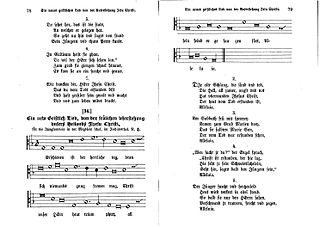Related Research Articles

A hymn is a type of song, and partially synonymous with devotional song, specifically written for the purpose of adoration or prayer, and typically addressed to a deity or deities, or to a prominent figure or personification. The word hymn derives from Greek ὕμνος (hymnos), which means "a song of praise". A writer of hymns is known as a hymnist. The singing or composition of hymns is called hymnody. Collections of hymns are known as hymnals or hymn books. Hymns may or may not include instrumental accompaniment. Polyhymnia is the Greco/Roman goddess of hymns.

Tahiti is the largest island of the Windward group of the Society Islands in French Polynesia. It is located in the central part of the Pacific Ocean and the nearest major landmass is Australia. Divided into two parts, Tahiti Nui and Tahiti Iti, the island was formed from volcanic activity; it is high and mountainous with surrounding coral reefs. Its population was 189,517 in 2017, making it by far the most populous island in French Polynesia and accounting for 68.7% of its total population; the 2022 Census recorded a population of 191,779.

The music of Papua New Guinea has a long history.

Music of Tonga refers to music derived from the island Tonga in the islands of Polynesia. Music of Tonga today generally falls under the category of traditional music that has withstood the test of time, or into one of the two opposing genres of religious and secular music. Tongan music can be either very emotional and somewhat modern with instrumental makeup including modern brass instruments, or conversely can be more traditional and consist of only drums and voices. In this way, Tongan music is very diverse despite the fact that it is contained to a fairly small island, which means that the different cultures and styles co-exist on the small land mass together without blending.
The music of the Cook Islands is diverse. Christian music is extremely popular. Imene tuki is a form of unaccompanied vocal music known for a uniquely Polynesian drop in pitch at the end of the phrases, as well as staccato rhythmic outbursts of nonsensical syllables (tuki). The word 'imene' is derived from the English word 'hymn'. Likewise the harmonies and tune characteristics / 'strophe patterns' of much of the music of Polynesia is western in style and derived originally from missionary influence via hymns and other church music. One unique quality of Polynesian music is the use of the sustained 6th chord in vocal music, though typically the 6th chord is not used in religious music. Traditional songs and hymns are referred to as imene metua.
The music of French Polynesia came to the forefront of the world music scene in 1992, with the release of The Tahitian Choir's recordings of unaccompanied vocal Christian music called himene tārava, recorded by French musicologist Pascal Nabet-Meyer. This form of singing is common in French Polynesia and the Cook Islands, and is distinguished by a unique drop in pitch at the end of the phrases, which is a characteristic formed by several different voices; it is also accompanied by steady grunting of staccato, nonsensical syllables.

Prior to the arrival of Europeans, the music of Tahiti was dominated by festivals called heiva. Dancing was a vital part of Tahitian life then, and dances were used to celebrate, pray and mark almost every occasion of life. Examples include the men's ʻōteʻa dance and the couple's 'upaʻupa.

Anglican church music is music that is written for Christian worship in Anglican religious services, forming part of the liturgy. It mostly consists of pieces written to be sung by a church choir, which may sing a cappella or accompanied by an organ.

The traditional music of Tuvalu consists of dances, including fatele, fakanau and fakaseasea. The influence of the Samoan missionaries sent to Tuvalu by the London Missionary Society from the 1860s resulted in the suppression of songs about the traditional religions or magic and many songs were lost. As the influence of the missionaries diminished in the 20th century the traditional dances were revived and the siva dance tradition from Samoa also became popular.

Church music is Christian music written for performance in church, or any musical setting of ecclesiastical liturgy, or music set to words expressing propositions of a sacred nature, such as a hymn.
Himene tarava is a style of traditional Tahitian music.
The ʻaparima or Kaparima (Rarotongan) is a dance from Tahiti and the Cook Islands where the mimicks (ʻapa) with the hands (rima) are central, and as such it is close to the hula or Tongan tauʻolunga. It is usually a dance for groups. There are two types of ʻaparima: the ʻaparima hīmene and the ʻaparima vāvā, the latter being performed with music only, and no singing. The music is often played on the guitar or the Tahitian ʻukulele.

"Es ist ein Ros entsprungen" is a Christmas carol and Marian hymn of German origin. It is most commonly translated into English as "Lo, how a rose e'er blooming" and is also called "A Spotless Rose" and "Behold a Rose of Judah". The rose in the German text is a symbolic reference to the Virgin Mary. The hymn makes reference to the Old Testament prophecies of Isaiah, which in Christian interpretation foretell the Incarnation of Christ, and to the Tree of Jesse, a traditional symbol of the lineage of Jesus. Because of its prophetic theme, the hymn is popular during the Christian season of Advent.
An imene tuki is a traditional hymn of the Cook Islands. It is accompanied singing noted for a drop and raise in pitch at the end of phrases, and rhythmic nonsensical syllables, comparable to Scat singing. Similar syllables and improvisations are found in Tahitian Himene tarava.
Imene reo metua: a Cook Islands / Rarotongan term; : they are formal traditional songs with tune and harmony, which are distinguished from the imene tuki style of the Cook Islands which are less formal, often grunted verses with nonsense syllables included for rhythmic effect. Most were brought to the islands by missionaries in the nineteenth century.

Music of the Czech Republic comprises the musical traditions of that state or the historical entities of which it is compound, i.e. the Czech lands. Czech music also constitutes a substantial part of the music culture of its direct predecessor, Czechoslovakia.

"Erschienen ist der herrlich Tag" is a German Easter hymn, with text and tune written by Nikolaus Herman and published in 1561. It has inspired musical settings by composers from the 17th to the 20th century. It appears in several hymnals, including the German Protestant hymnal Evangelisches Gesangbuch. Other hymns, especially Easter hymns, in both German and English, are sung to the same melody.
Hymnody in continental Europe developed from early liturgical music, especially Gregorian chant. Music became more complicated as embellishments and variations were added, along with influences from secular music. Although vernacular leisen and vernacular or mixed-language carols were sung in the Middle Ages, more vernacular hymnody emerged during the Protestant Reformation, although ecclesiastical Latin continued to be used after the Reformation. Since then, developments have shifted between isorhythmic, homorhythmic, and more rounded musical forms with some lilting. Theological underpinnings influenced the narrative point of view used, with Pietism especially encouraging the use of the first person singular. In the last several centuries, many songs from Evangelicalism have been translated from English into German.
Church music during the Reformation developed during the Protestant Reformation in two schools of thought, the regulative and normative principles of worship, based on reformers John Calvin and Martin Luther. They derived their concepts in response to the Catholic church music, which they found distracting and too ornate. Both principles also pursued use of the native tongue, either alongside or in place of liturgical Latin.
References
- 1 2 Handy, Edward Smith Craighill; Winne, Jane Lathrop (1925). Music in the Marquesas Islands. Bernice P. Bishop Museum. pp. 8–9.
- ↑ Ellingham, Mark (1999). The Rough Guide to World Music. Rough Guides. p. 228. ISBN 978-1-85828-636-5.
- ↑ Century Illustrated Monthly Magazine ... Scribner & Company. 1910. p. 705.
- ↑ Forman, Charles W. (1982). The island churches of the South Pacific : emergence in the twentieth century. Maryknoll, NY: Orbis Books. ISBN 0-88344-218-3. OCLC 7945941.